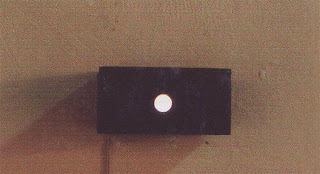by Elvia Rosa Castro
(Huella cósmica, by Glenda León)
(In my head, by Sandra Ramos)
It has been said that one of the main works of the 20th century is The Creative Evolution (1907) by Henri Bergson. In it, the French philosopher develops two very dear concepts of philosophical thought: that of duration and that of élan or vital principle. But more than these, I would like to draw attention to another no less interesting one: according to Bergson, the human being qualifies his capacity to deal with nature through the construction of artificial objects, i.e., the human being is homo faber.
At least according to the references I have, I seem to be facing the first denial of the modern super myth, consisting in the human being as homo sapiens.1 But that Bergson qualification is only a symptom: together with others we shall see later on, it synthesizes an epochal sensibility or a certain rebelliousness. It is a kind of disobedience already present in Nietzsche since his work The Origin of Tragedy. A questioning of the absolute understanding of all reality as something rational and therefore, of abstraction.
Shortly thereafter there appear, wildly, the homo ludens (Huizinga), the theoreticus (Spranger), the simbolicus by Cassirer and so on along the past century, until coming to the radical posthuman, by Jeffrey Deitch, the "liquid identity" by Sandy Stone and the cyborg, by the North American Donna Haraway, also belonging to the past century.
Undoubtedly all taxonomies respond to an unceasing search of human identity in that urge of the human being to explain, not only his place in the universe, but to expose the linguistic variables through which he creates and explains to himself his own world. To search, ask and inquire about our identity has been an obsession of western civilization, without bearing in mind that it is a construction we have built ourselves. That is to say, the result of the representation. With his proverbial mastery, Wittgenstein would say it is a linguistic masking. And any ordinary Italian would say it is nothing but a cosa mentale.
Thinking about our identity entails at least the sensation that we are divided, that behind the appearances is a hidden essence we must unmask, and at the same time, it does not fail to evidence a fundamentalism of the self, egocentric. And I am not only speaking of a division but of a belief consisting of being separated from the rest, from the others: the union of the first person singular pronoun with the verb to be, i.e., I am, shows what I wish to point out. We are in the presence of a pretentious and presumptuous expression, so artificial that it has become natural, and vice versa.
If the thinker Alexis Jardines were asked in this regard, he would say that the identity is given (of existing) only in the body (soma), the scenario where the semen lodging the individuality of the potential human being and the sema, minimum space where significance and significant interrelate, minute zone that ensures the existence of the sign.1
Then it is not casual that almost all artistic explorations on the attributes of our identity end in a representation of the human body. Although perhaps that has another explanation in the need of man to legitimize himself in the face of the dominion of theology and science 2, which historically have exiled him from the center, banishing him to ridiculous planes. And the easiest that the artist found was the externalist portrait, the bust or the figurative monumental sculpture. Man thought himself identical in his reply, in a cloning of his phenomenalist traits transferred to the canvas, to bronze or to any other material considered noble and valuable. That was the most common way of representing and at the same time, of legitimizing oneself. One could say that we are in the presence of an identical identity, and therefore, of a false one.
While thinkers and philosophers run riot listing a number of adjectives —since in the end sapiens, faber, ludens, etc., etc., are epithets— pointing to the capacities of the human being, at least the artists —who dominate the image and whose mind is, let us say, maladjusted—think of themselves in more punctual terms. There are no generalizations in their works: they are humbler in the megalomania, although this sounds like a paradox.
But the most interesting about it all, according to my opinion, is the fact that both of them may reach that variety of propositions, of thinking themselves and speaking about identity thanks to their ability to become lost in thought (ego) and of changing (alter ego): a theoretical discovery we owe to the Spaniard José Ortega y Gasset and to professor Alexis Jardines who reconquered it for the Cubans of these days.
However, that dis-covering, that un-covering, that honest revealing himself in art continues to be, in addition to a sincere and even heartbreaking exercise, a strictly modern and inevitable adventure that, in the end, becomes a representation of the representation. A masking. But it is quite possible that appearing otherwise, far from the mimesis and the copy and without the philosophical extremism, might be the way to make us approach ourselves, since the search of identity is nothing but a de-identifying, a rehabilitating of all that egotistic addiction.
To identify oneself in that way is nothing but the evidence that instead of being robust we are relapsing… thank God.
Regarding what I wrote, two proposals come to my mind that we should take into consideration because they come precisely from art and because both deny the permanence if speaking of unity: Ernesto Leal made a video entitled Identidad imposible, a work that questions every attempt to search in our condition. He was moved to do it, perhaps, by the forthrightness of the "I is another one" or the Heraklean maxim that everything flows and consequently there is no foundation. Also Rafael Acosta, in a text on the work by Rocío García, states that "man (or woman) is a stranger to himself. Identity is mutation and temporariness, it is strangeness and darkness"3. I doubt that Ernesto thinks of something hidden, while Rafael, on the contrary, does, but the fact that they arrive to similar conclusions is odd and turns them into emphatic anti-modern and unbelievers, though I do not think they will renounce, like the holy rest of mankind, to let themselves be seduced by those mysteries we invent ourselves, of changing our ego, of demanding ourselves, in the end, who we are.
[1] Let us not forget that the term comes from science –Linneo- and not from philosophy.
2 Alexis Jardines. El cuerpo y lo otro. Introducción a una teoría general de la cultura. La Habana : Editorial de Ciencias Sociales, 2004.
3 The reasonings by Jardines are closer to the artistic modus operandi than to the philosophical one.
4 The ideology in one of its variables: politics, was to follow.
5 Rafael Acosta de Arriba. "Entre Fassbinder y Tarantino". In Caminos de la mirada. La Habana : Ediciones Unión, 2007, p. 190.


No comments:
Post a Comment